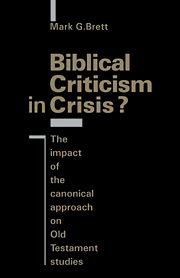Book contents
- Frontmatter
- Contents
- Acknowledgements
- List of abbreviations
- Introduction: Setting the scene
- 1 Distinguishing interpretative interests
- 2 The development of canonical exegesis
- 3 ‘Introduction’ and Old Testament theology
- 4 Has Childs fallen into Gabler's ditch?
- 5 Textual intentions and histories of reception
- 6 The future of the canonical approach
- Notes
- Bibliography
- Bibliographical key to the works of Brevard S. Childs
- Index of Old Testament references
- Index of subjects
- Index of authors
5 - Textual intentions and histories of reception
Published online by Cambridge University Press: 10 October 2009
- Frontmatter
- Contents
- Acknowledgements
- List of abbreviations
- Introduction: Setting the scene
- 1 Distinguishing interpretative interests
- 2 The development of canonical exegesis
- 3 ‘Introduction’ and Old Testament theology
- 4 Has Childs fallen into Gabler's ditch?
- 5 Textual intentions and histories of reception
- 6 The future of the canonical approach
- Notes
- Bibliography
- Bibliographical key to the works of Brevard S. Childs
- Index of Old Testament references
- Index of subjects
- Index of authors
Summary
REDACTORS, RECEPTION AND TEXT IN THE WORK OF CHILDS
One of the distinctive features of Childs's work is his stress on the reception and ordering of traditions within the biblical period – the canonical process (e.g. 1985: 23). He resists, however, the practice of reconstructing earlier layers of the text ‘apart from their reception and transmission within the community of faith’ (1985: 11–12). The end products of the canonical process are the object of exegetical attention, and the earlier layers of a text are not to be understood independently of later editing and redaction. The final composition of a biblical text is greater than the sum of its parts. This also applies to the parts played by individual biblical editors; their merely individual contributions have been effaced so that attention can be focused on the text itself. Yet more than this, canonical exegesis can also examine textual effects which may or may not have been intended by particular redactors (1984a: 49; c.f. 1979: 79, 661). As if to soften this exegetical licence to seek out unintended effects, Childs also speaks of ‘the intention of the text’ or of ‘canonical intentionality’ (cf. 1979: 79, 300, 393, 486, 645). In this chapter we shall address the issue of whether all these separate arguments about reception and textuality can be held together in a coherent whole.
Can we, for example, make any sense of the idea that communicative intentions can be attributed to texts, rather than to human agents, or is this, as Barr and Oeming suggest, just a ‘mystic’ anthropomorphism?
- Type
- Chapter
- Information
- Biblical Criticism in Crisis?The Impact of the Canonical Approach on Old Testament Studies, pp. 116 - 148Publisher: Cambridge University PressPrint publication year: 1991



